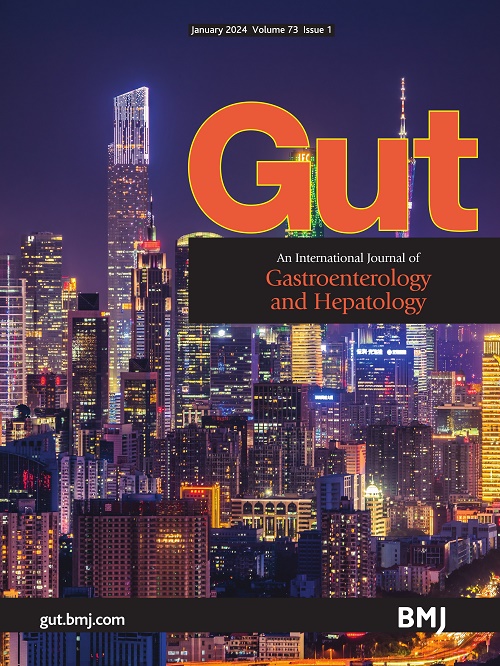Validation of the definition of gastro-oesophageal junctional zone: an immunohistochemical study using resected mucosal specimens
IF 23
1区 医学
Q1 GASTROENTEROLOGY & HEPATOLOGY
引用次数: 0
Abstract
In 2022, the gastro-oesophageal junctional zone (GOJZ) was proposed at the International Consensus Conference in Kyoto as the area extending 1 cm proximally and 1 cm distally from the gastro-oesophageal junction (GOJ), defined by the distal end of the palisade vessels (DEPV).1 2 The definition of GOJ remains a matter of debate. In the globally recognised GOJ cancer classification, a Siewert type II tumour is an adenocarcinoma located 1 cm above to 2 cm below the GOJ, representing a ‘true carcinoma of the cardia’.3 Although the distribution of cardiac glands should determine GOJZ, distinction between native cardiac glands and metaplastic changes at the GOJZ remains a histological challenge due to conventional H&E staining limitations. The previous studies failed to differentiate between pyloric/pseudopyloric metaplasia and cardiac or oxyntocardiac glands, as they did not use immunohistochemical stainings of pepsinogen I (PPGI). This was a single-centre retrospective study that analysed GOJ mucosal specimens that had been resected via endoscopic submucosal dissection for treating refractory gastro-oesophageal reflux disease (GORD) (online supplemental material 1).4 Only those cases where the palisade vessel was identifiable in more than half of the specimens were included, resulting in an analysis of 11 cases comprising 120 slices from 51 patients who underwent endoscopic mucosal resection. Mucosal specimens containing the GOJZ were analysed to identify cardiac glands, parietal cells, and chief cells or pyloric/pseudopyloric metaplastic glands, using immunohistochemical staining for MUC6, H+/K+-ATPase and PPGI (online supplemental material 2). The distances from the DEPV to the proximal and distal edges of the cardiac glands, …胃-食管交界带定义的验证:使用切除粘膜标本的免疫组织化学研究
2022年,在京都召开的国际共识会议上,胃-食管交界处(GOJZ)被提出,作为胃-食管交界处(GOJ)近端和远端分别延伸1cm和1cm的区域,由栅栏血管(DEPV)远端定义。12 GOJ的定义仍然是一个有争议的问题。在全球公认的GOJ癌症分类中,Siewert II型肿瘤是位于GOJ上方1厘米至下方2厘米的腺癌,代表“真正的贲门癌”虽然心脏腺体的分布决定了GOJZ,但由于常规H&E染色的限制,区分天然心脏腺体和GOJZ的化生变化仍然是组织学上的挑战。先前的研究没有使用胃蛋白酶原I (PPGI)的免疫组织化学染色,因此未能区分幽门/假幽门化生和心脏或心氧腺。这是一项单中心回顾性研究,分析了通过内镜下粘膜夹层切除治疗难治性胃食管反流病(GORD)的GOJ粘膜标本(在线补充资料1)仅包括那些在一半以上的标本中可识别栅栏血管的病例,结果分析了11例,包括51例接受内镜粘膜切除术的患者的120片。采用MUC6、H+/K+- atp酶和PPGI的免疫组化染色,对含有GOJZ的粘膜标本进行分析,鉴定心腺、壁细胞、主细胞或幽门/假幽门化生腺(在线补充资料2)。从深静脉到心脏腺体近端和远端边缘的距离…
本文章由计算机程序翻译,如有差异,请以英文原文为准。
求助全文
约1分钟内获得全文
求助全文
来源期刊

Gut
医学-胃肠肝病学
CiteScore
45.70
自引率
2.40%
发文量
284
审稿时长
1.5 months
期刊介绍:
Gut is a renowned international journal specializing in gastroenterology and hepatology, known for its high-quality clinical research covering the alimentary tract, liver, biliary tree, and pancreas. It offers authoritative and current coverage across all aspects of gastroenterology and hepatology, featuring articles on emerging disease mechanisms and innovative diagnostic and therapeutic approaches authored by leading experts.
As the flagship journal of BMJ's gastroenterology portfolio, Gut is accompanied by two companion journals: Frontline Gastroenterology, focusing on education and practice-oriented papers, and BMJ Open Gastroenterology for open access original research.
 求助内容:
求助内容: 应助结果提醒方式:
应助结果提醒方式:


